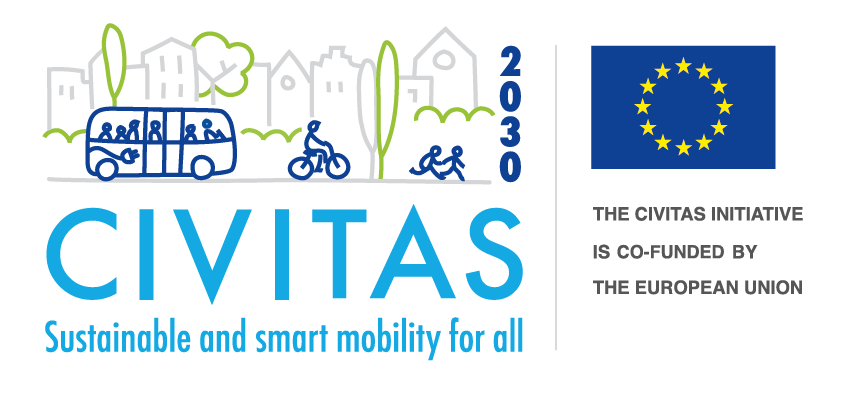Bike-based solutions in urban logistics
Bike-based solutions in urban logistics
By Rosa van Gestel, Lorena Axinte (Bax & Company)
Cycle logistics offer promising solutions in urban environments, as a sustainable response to the rising on-demand economy and its impact on last mile deliveries. A variety of smaller, light vehicles and mobility hubs (more info here) enables a zero-emission cycle-based transport alternative for different types of markets. Aside from minimising the impact on the environment, bikes offer numerous benefits for companies (e.g., lower purchase and maintenance costs, health benefits for drivers) and cities (e.g., increased road safety, reduced noise, better use of public space). However, ensuring that bike-based solutions realise their full potential requires a careful examination of all aspects that may influence their uptake.
The team at ULaaDS partner Bax & Company interviewed four companies that have successfully integrated cycle-based deliveries in their operations in order to learn more about their business and operational models. Helped by the growing academic literature on cycle logistics, we examine the factors which support the uptake of cargo bikes and similar vehicles in urban logistics.
Examples of integrated cycle logistics
bpost (BE)
Cycle logistics have been part of bpost’s operations since it first started with mail deliveries. Now that bpost – the largest player in Belgium’s post and parcel market – is transitioning towards a zero-emissions fleet by 2030, bikes are increasingly being used for delivering not just post, but also parcels of different sizes.
Gregory Perez (Urban Logistics Project Manager at bpost) points out that the choice of vehicles in their fleet is mainly determined by the physical volume of mail and parcels. When implementing cycle logistics, bpost initially struggled with the bikes’ lower load capacities as compared to regular vans. In order to integrate bikes into their fleet in an economically feasible way, bpost needs to operate in areas with high drop densities and sufficient micro-hubs to replenish, so that as many packages can be delivered in a tight timeframe. However, to achieve this, appropriate infrastructure is needed, and urban policies can be helpful to accelerate the mobility transition.
Considering external factors that influence the uptake of cycle logistics, Perez emphasizes that restrictive measures for car or van use could play an important role in the success of cycle logistics. For instance, multiple cities in Belgium (e.g., Mechelen, Gent), have introduced regulations that limit access for motorised vehicles in several streets. This is supported by research finding that these deteriorating conditions for conventional vehicles are among the most influential factors for businesses’ decision to purchase cargo bikes.
Adequate legislation can accelerate the transition to zero-emission deliveries and help to implement greener logistics.
Apart from establishing appropriate legislative and infrastructural measures, bikes must be prepared for cycle logistics as well. bpost started with the use of cargo bikes. However, after several years of testing various types and manufacturers, they concluded that the cargo bikes are not durable enough for the volumes they need to transport on a daily basis. The combination of carrying cargo with a vehicle of limited strength, the frequency and the street surface (e.g., cobble stone pavement, potholes), results in bended axles. Therefore, bpost has shifted towards the use of regular bikes with trailers, which have shown to be much sturdier. In addition, trailers can be uncoupled and walked within pedestrian areas, representing a better fit for their cycle-based operations.
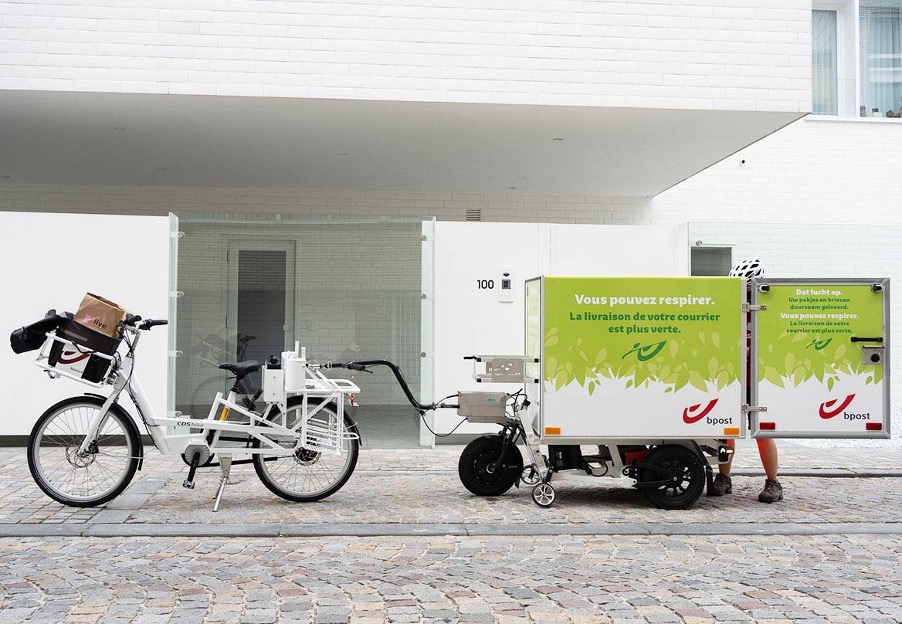
Employees who tried bikes for their operations found that they could work more efficiently and convinced other mailmen to swap their vans for bikes with trailers.
For drivers, transitioning from using vans or cars to bikes is not always easy. Perez highlights the importance of changing mindsets instead of enforcing new ways of working. Giving employees the opportunity to test out bikes and sharing their experience can be helpful in guiding the transition towards cycle logistics. In Mechelen, for instance, several employees who tried the bikes found that they could win time and work more efficiently. Their positive attitude convinced other employees to swap their vans for cargo bikes. Although changing mindsets and behaviours takes time, Perez acknowledges that change management is key to successful implementation of cycle logistics.
PostNL (NL)
As The Netherlands’ largest mail and parcel deliverer, PostNL aims to provide zero-emission last-mile deliveries in city centres by 2025, and to have an entirely emission-free fleet for last-mile deliveries by 2030. The use of sustainable alternatives for vans is part of their vision for sustainable city logistics, building on the foundation of the organisation’s origins – the delivery of letters carried out on foot and by bicycle for many years.
Although PostNL has recognised the potential of cargo bikes for urban logistics for almost ten years, there is still room to expand in this direction. Similar to bpost’s experience, PostNL found that although drivers are often enthusiastic after trying cargo bikes, the durability of the bike itself is often insufficient for their heavy operations. However, the ongoing research and development phase should enable PostNL to integrate cargo bikes in their fleet in the near future. Jorick Dam (Program Manager Sustainability at PostNL) mentioned they could use cargo bikes similarly to their light electric freight vehicles (LEFVs): in urban areas with high drop densities. PostNL aims to use the cargo bikes and LEFVs for the inner cities with narrow streets and canals, and the larger electric vehicles in less dense areas or for larger parcels.
When drivers change from conventional vehicles to LEFVs or cargo bikes, they feel like ambassadors of the city, and are very proud.
According to Dam, one issue that PostNL encountered when rearranging the logistics chains to include the use of LEFVs and cargo bikes, is the communication at City Hubs during the transhipment process. Traditionally, vans were loaded and driven by the same person, transporting the parcels from the sorting depot to the end receiver in one go. However, with LEFVs and cargo bikes, an additional hub is required to load parcels onto the smaller vehicles for the last miles in city centres. Besides the additional costs associated with the micro-hub, this means that a smooth process is required to load the parcels into the cargo bodies in the correct order. PostNL has developed a so-called Tetris-tool, which examines the pile of parcels and makes a plan for the compartments of a truck’s roller cages, that are later used to load the smaller vehicles with. The algorithm, developed by PostNL helps employees to load the smaller vehicles in the most efficient way, both in terms of space and the order for delivery routes (more info on their digitalisation strategy here). This enables PostNL to fit parcels of different shapes and sizes in the vehicle, that would otherwise have been delivered by conventional vans. These types of innovations are promising, but also highlight the effort needed to rearrange logistics operations to accommodate more sustainable vehicles for last-mile delivery.
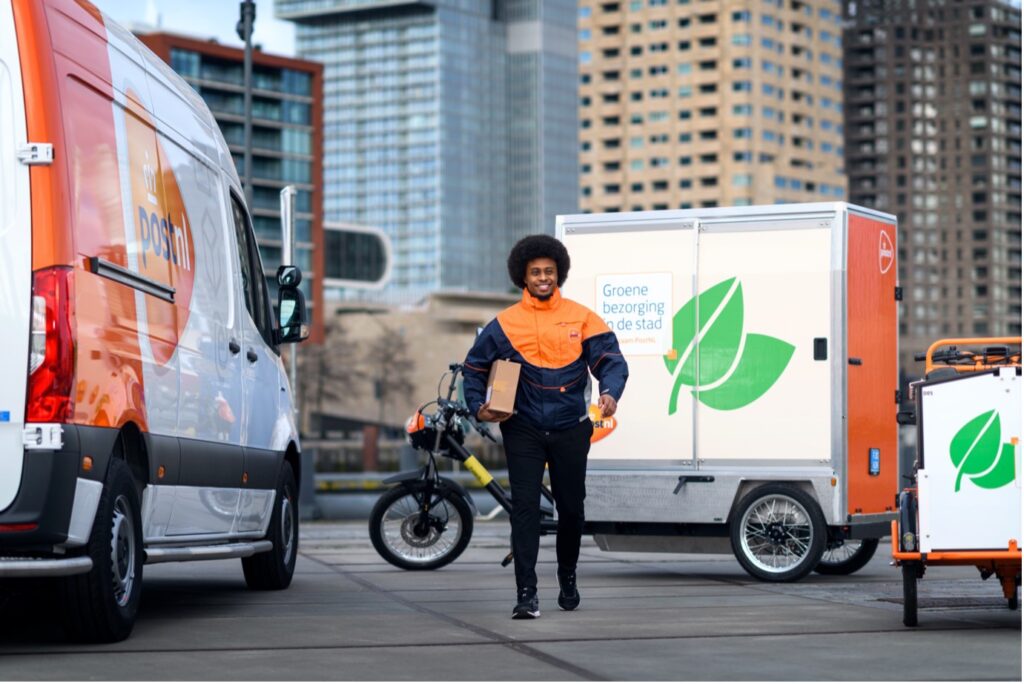
Pedal Me (UK)
Unlike bpost and PostNL, two large logistics service providers that are exploring cycle-logistics for their operations along with other types of vehicles, Pedal Me is a smaller, London-based company which focuses solely on delivery by bike. Pedal Me carries anything that conventional delivery vans can – from coffee to furniture, and from beer barrels to humans. Their mission is to remove vans from the streets, shifting from a motor vehicle culture to a biking culture.
While being carried in one of their bikes, Christopher Dixon (Co-founder and Head of Training at Pedal Me) explained in our online interview the Pedal Me approach to integrating bike-based solutions in urban logistics. As Pedal Me tries to replace the work done by van-based logistics service providers, the company is competitive across the entire logistics market. However, competing with larger logistics service providers is not always easy. Often, people assume that trips made by bikes are much cheaper than trips made by conventional vehicles. In a way, this is true: depending on the right infrastructure and skills of the rider, bikes can be very quick and win time. However, other costs (e.g., wages, electricity bills for charging bikes, or hub rentals) may not allow small companies like Pedal Me to reduce the prices significantly. Still, customers move to Pedal Me because they perceive them to be an environmentally friendly and cheaper alternative, especially in times where fuel prices are increasing.
Pedal Me’s ability to carry heavy weights and high volumes is mainly thanks to their bike design. Dixon emphasizes that they do not use regular cargo bikes, but the specific Pedal Me bike produced by Urban Arrow, with which use is not restricted by volume. Like bpost and PostNL, Pedal Me has experienced some issues regarding the durability of delivery bikes. However, as the main aim of the business is to remove vans from the street and replace them with bikes, Pedal Me is motivated to find solutions for these issues as quickly as possible. Their collaboration with Urban Arrow allows them to improve the quality of their bikes continuously.
Cycle logistics come with issues. As entrepreneurs on a mission to remove vans from the streets, we are committed to fixing these issues.
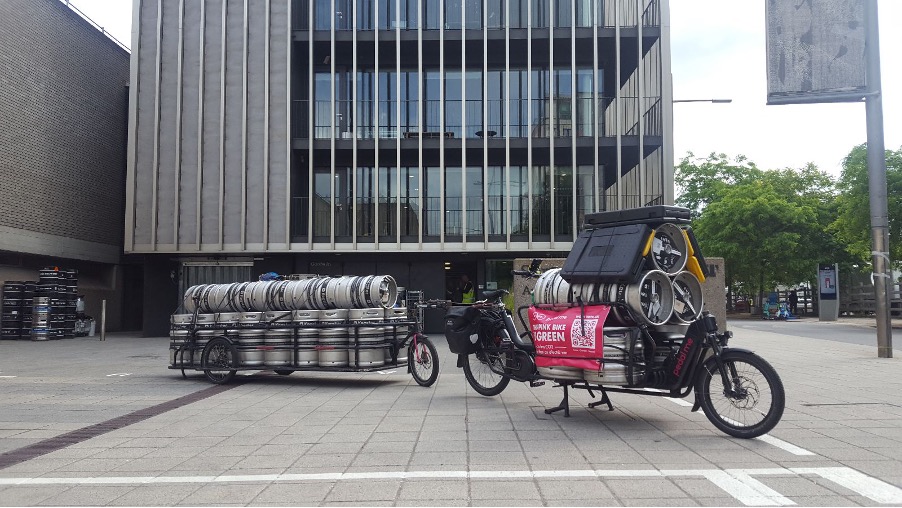
Still, making deliveries with bikes also requires drivers who know how to use them. Besides the different handling skills required as opposed to using regular bikes, the integration of Pedal Me bikes into the traffic network is also important to consider. In contrast to driving vans, cyclists have much more social interaction, using eye contact and gestures to move through traffic. To prepare riders to deliver goods and passengers quickly and safely, Pedal Me offers training. For their own employees, these trainings are mandatory, ensuring a layer of risk mitigation.
A motor vehicle culture is not the same as a bike culture. Cycling is about communicating in space, with people who are as vulnerable as you are. There is a lot of social interaction through eye contact and gestures.
The local public authority recognizes Pedal Me’s work. As the trainings benefit society through behavioural change and eventually decarbonisation, transport planning department’s cycling budgets can be allocated to Pedal Me, supporting their work. Dixon points out that governments can help the shift towards cycle logistics by providing these types of support. However, this requires awareness, knowledge and motivation throughout all levels of the public authorities’ framework, as well as guidance by the higher governmental levels.
Urbike (BE)
The Brussels-based company Urbike started in 2018 as an applied research project, where the initiators collaborated with larger companies such as bpost and Delhaize to show the potential of cycle logistics in urban areas. Today, the project has evolved into a company with 45 employees, offering not only bike-based delivery services, but also material, training, and advice on business model transformations towards cycle logistics.
Urbike’s largest customer is a parcel deliverer, who employs Urbikes’ last-mile services to make their own operations more environmentally friendly and efficient. Although the regularity and volume of the small parcel (under 30 kg) flow makes it highly suitable to be transported by bikes, Renaud Sarrazin (Co-founder and Expert Urban Logistics at Urbike) points out that competition in this logistics flow is high. Therefore, Urbike additionally focuses on small volumes such as fresh and dry food, pharmaceutical goods, flows that stay within the city (e.g., local B2C delivery of books and flowers), or even small orders for construction sites. Pick-ups and first miles can also be covered by Urbike, providing a reversed logistics service while simultaneously making their operations more efficient by avoiding cycling with empty cargo. Urbike tries to consolidate orders where possible. It is therefore crucial that delivery box sizes are standardized (e.g., by Euro container dimensions) and used by the variety of logistics stakeholders, to ensure smooth transhipment and consolidation.
To keep track of all (reversed) logistics, each parcel or product has a digital twin. An automated system communicates with customers to continuously inform them about the status of the order, preventing situations where no one is present to receive the product. Similar to the other interviewed companies, Urbike has experienced issues with the durability of bikes. While previously they did not teach their couriers how to fix small breakdowns, Urbike’s trainings now include equipping their drivers with skills to repair the most common technical issues. Additionally, two mechanics joined the company and are responsible for maintenance, prevention, and reparation of half of Urbike’s vehicles. The other half is leased from DOCKR, a delivery bike company who offer subscriptions including a maintenance service.
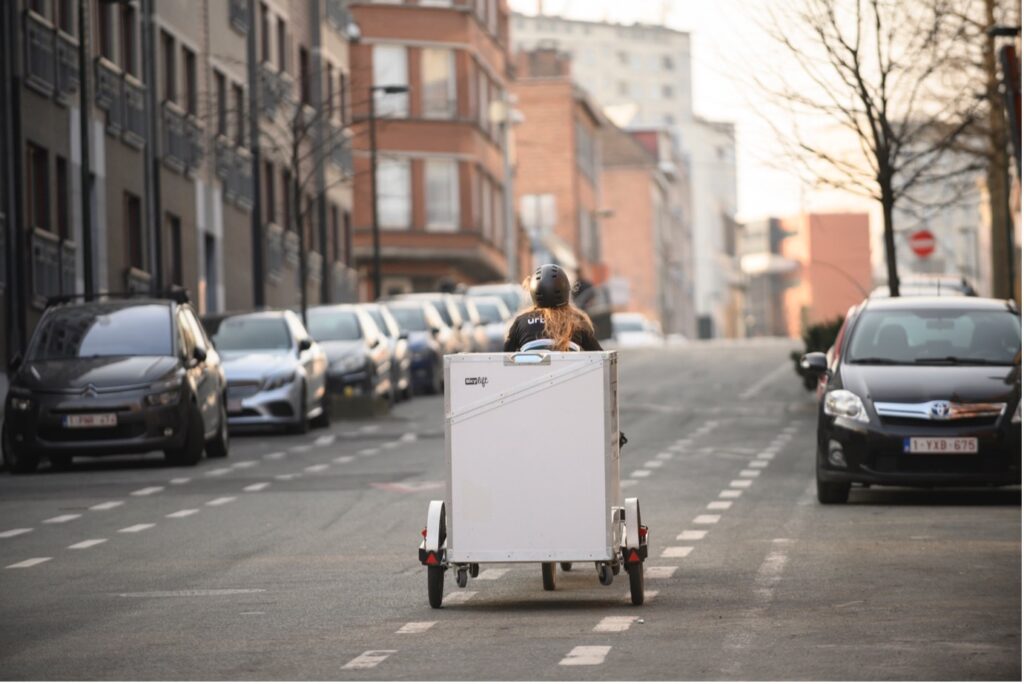
Next to the technical expertise and automated system, Sarrazin highlights the importance of the human workforce at Urbike. The company ensures high quality, long-term job contracts with fair wages. Employees are trained and supported by a mentor teaching them how to drive the bikes, handle niche flows with special requirements (e.g., pharmaceutical products, flowers), and solve issues when they occur (e.g., absence of a receiver, small breakdowns of the bike). The company’s care for this human workforce results in fair prices for their customers. Although these prices may not be the lowest in the logistics sector, they do convey an educational message to the customer, showcasing the environmental, social, and economic sustainability of their bike-based deliveries.
What we need from the government is recognition. Only if they see cycle logistics as a separate sector, can they support its uptake effectively.
While bike-based solutions have the potential to cover 30% of urban last-mile deliveries, they currently only encompass less than 1%. To increase its use and impact, Sarrazin highlights the importance of governments’ recognition of cycle logistics as a separate sector. This way, public authorities can provide fiscal and financial incentives, as well as change land use plans to allow more city- and micro-hubs. Additionally, they can provide expertise on developing educational programmes focused on cycle logistics, such as licences for deliverers on bikes. These supportive regulations can be combined with restrictive measures; however, the latter must be handled carefully according to Sarrazin. Such “smart constraints” would enable governments to discourage conventional van-use, without making the necessary high-volume deliveries (e.g., to supply supermarkets and city hubs) by vans and trucks impossible.
Factors supporting the integration of bike-based solutions in urban logistics

Infrastructure
Total costs of conventional vehicles should be perceived higher than the costs associated with the use of bikes in order for bikes to be a more appealing fleet choice for logistics providers. This also includes the efficiency of the vehicle: if bikes win time, they save money. In a more car- or van-oriented city layout, bikes may not be faster than conventional vehicles, and thus may not offer significant economic benefits. Ensuring safe roads with lower speeds, appropriate parking facilities, and charging points for electric bikes would allow cycle-based solutions to make use of their advantages.

Active role of government
The interviewed companies recognise the effectiveness of both restricting and supportive regulations. Restrictive measures include for example ensuring parking fees for double parking, or imposing urban vehicle access regulations (UVARs), such as the implementation of low or zero emission zones. Enforcing these regulations is crucial to deter logistics service providers from using conventional vehicles. It also requires governments to differentiate between types of vehicle, to avoid having the same rules for vehicles of varying sizes and speeds. This differentiation is important for bikes and other small zero-emission vehicles to make use of their advantages over conventional vans. Surely, these restrictive measures go hand-in-hand with supportive regulations, giving cyclists priority and privileges in traffic.
Additionally, public authorities could support companies that focus on or shift towards cycle logistics by providing funding or subsidy schemes. However, it is important to be aware of the long-term impact of those financial incentives; often when funding opportunities end, companies struggle to find alternative financing. Additionally, they may lead to a lower motivation of manufacturers to cut down the prices of delivery vehicles, thus, a careful execution is necessary. Combining financial incentives with supportive regulations such as educational programmes or making space for more city- and micro-hubs may be beneficial.
Involvement in projects and trials that promote cycle logistics, as well as using bikes for their own logistics operations (directly or via procured services), are additional actions that governments can take.

Change management
Change management is crucial, especially for larger logistics providers that want to shift to cycle logistics as part of their operations. Employees who are used to driving cars and vans may be reluctant to switch to bikes. Still, all interviewees indicate that after employees try bikes, they are enthusiastic about using them for their deliveries. Therefore, giving employees the opportunity to test bikes, providing training, listening to their needs, sharing positive experiences, and increasing environmental awareness within the company would help manage the change towards cycle logistics.

Smooth transhipment at hubs
When bikes are used for last-mile deliveries, extra hubs in the city are needed to ensure bikeable distances and refills. This also requires an extra step in the logistics process: transferring goods from the larger vehicles into the cargo bodies or trailers of the bikes. Multiple people are involved in this process, which means that good communication is needed to have a smooth transhipment and ensure that the parcels are loaded in the vehicles in the correct order. Digitalisation of data, such as that seen in PostNL and Urbike, can smoothen this process, as well as the use of standardized delivery box dimensions by all logistics stakeholders.
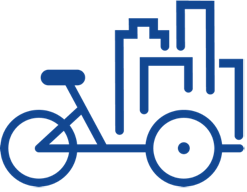
Solution-thinking
The commitment illustrated by Pedal Me has shown to be effective in addressing the durability issues with the bikes. Since their business is built upon a motivation to remove vans from the road and replace them by bikes, they are determined to solve any issues associated with the vehicle. A similar vision is present at Urbike, who are committed to providing their drivers with the best training and material possible. This solution-thinking found at these smaller companies focused on bike-based solutions is crucial and may be useful for the larger logistics service providers to adopt cycle logistics more effectively as well.
ULaaDS connection
Being zero-emission transport vehicles, bikes play an essential role in future urban logistics, and accordingly, in the ULaaDS project. The European Commission recognizes the potential and importance of cycle logistics, as mentioned for instance in the New EU Urban Mobility Framework. EU projects like ULaaDS allow cities and relevant stakeholders to explore the possibilities of cargo bikes and similar vehicles together, contributing to a better and wider uptake of these zero-emission logistics solutions.
This Insight was developed by Bax & Company under the ULaaDS project, with valuable input from Gregory Perez (bpost), Jorick Dam (PostNL), Christopher Dixon (Pedal Me) and Renaud Sarrazin (Urbike).
References
City Changer Cargo Bike. (2021). The Cargo Bike Friendly City. A comprehensive guide
to accommodating cargo bikes in cities. Retrieved from http://cyclelogistics.eu/wp-content/uploads/2022/09/The-Cargo-Bike-Friendly-City-Guide-Screen_0.pdf
European Commission. (2021). The New EU Urban Mobility Framework. Retrieved from https://transport.ec.europa.eu/system/files/2021-12/com_2021_811_the-new-eu-urban-mobility.pdf
Narayanan, S., Gruber, J., Liedtke, G., & Antoniou, C. (2022). Purchase intention and actual purchase of cargo cycles: Influencing factors and policy insights. Transportation Research Part A, 155, 31-45. https://doi.org/10.1016/j.tra.2021.10.007
Ploos van Amstel, W., Balm, S., Warmerdam, J., Boerema, M., Altenburg., M., Rieck, F., & Peters, T. (2018). City logistics: Light and Electric. LEFV-LOGIC: Research on Light Electric Freight Vehicles. LEFV-LOGIC. Retrieved from https://www.hva.nl/binaries/content/assets/subsites/kc-techniek/publicaties/lefv-logic.english.pdf
Vasiutina, H., Szarata, A., & Rybicki, S. (2021). Evaluating the environmental impact of using cargo bikes in cities: a comprehensive review of existing approaches. Energies, 14(20), 6462. https://doi.org/10.3390/en14206462



